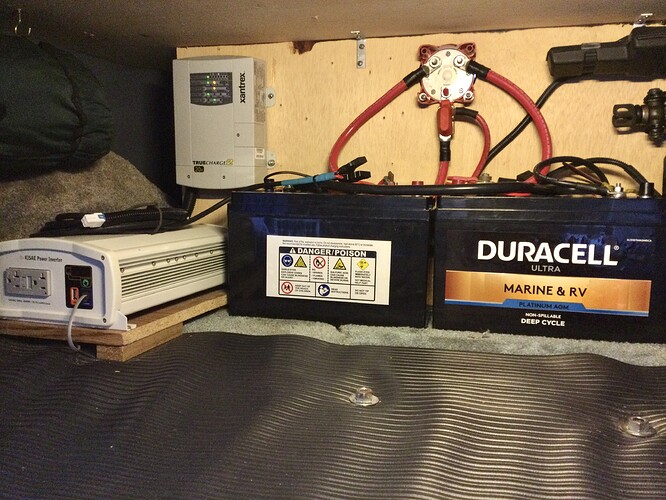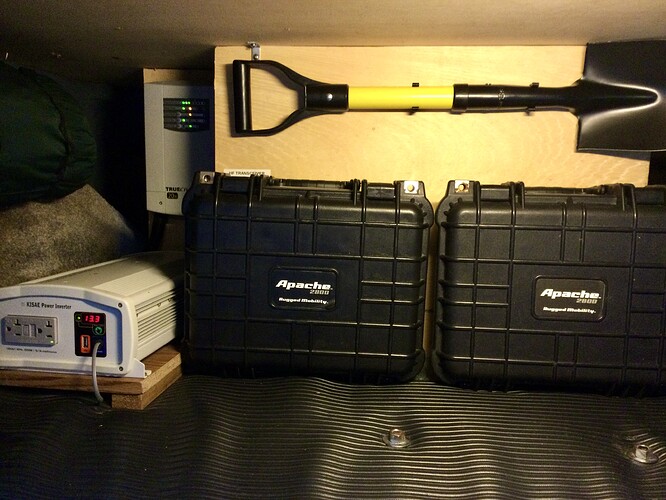Hello I am exploring some power options for my 93 Plymouth Voyager. I don’t live in the van full time but camp in it most weekends and am doing a month long ski trip in Oregon next month. I am looking for a small solar power set up that will be able to charge camera batteries, a MacBook, a Bluetooth speaker, my phone and possibly run a boot heater to dry out equipment. Obviously not trying to run everything at the same time but looking for something that has enough power to run the boot heater and charge something for a night. The Voyager is not a very large van so something compact is a must. I have been looking into the Goal Zero Yeti 200x + Nomad 20 solar kit or the Jackery Explorer 240 with the SolarSaga 60w panel but am curious if anyone has any experience with either system.
Any advice or suggestions are greatly appreciated!
Thanks!
I don’t know about those kits, and you might get away with charging everything on your list with 60 watt panel, but likely not run the boot heater. Anything that produces heat will use a bunch of power.
You need to figure out an energy budget, meaning that you need to calculate how much power you need, and then come up with enough battery power and solar to meet those needs.
All of your chargers and appliances will be marked in terms of how much power they use. For example, your laptop charger may say 85 watts and your boot dryer may say 500 watts. A phone charger may consume 10 or 15 watts. DC appliances may state milliamp-hours or amp-hours instead of watts. There’s 1000 milliamps in one amp.
To come up with a number that you can use, you have to convert everything to the same units. Batteries are rated in amp-hours (amps in short), so it makes sense to convert everything to amp-hours.
For example, to convert what your 85 watt laptop charger uses in amps use Ohms Law to convert watts (power) to amps (current). 85 watts divided by 12 volts equals 7.1 amps. Then you’ll have to multiply the 7.1 amps by the number of hours you use it per day. Let’s say it charges for 3 hours a day, so that’s 21.3 amps per day.
Now let’s assume in the laptop example that your battery has a capacity of 50 amps, and your solar panel is 60 watts. The battery only stores power, but has to be kept charged. Without charging, your battery can power your laptop for a little more than two days before it needs to be charged. It will go dead after two days. You have to supply enough charging capacity to keep it charged, and enough charging to cover all your needs on a daily basis.
You spoke of a 60 watt solar panel. 60 watts divided by 12 volts equals 5 amps. Let’s say you get 6 hours of uninterrupted sun on your panel every day. That’s 30 amps. So with a 60 watt panel you’ll have enough to power the laptop indefinitely as long as you’re always in the sun, and you don’t have more than one cloudy day every 6 days or so.
Charging always takes a little more power than the battery can give, so 30 amps is probably the minimum you’ll need for the laptop.
Do these calculations for everything you plan to use to establish a power budget.
Also, powering things with 12 volt DC (no inverter) is far more efficient than converting 12 volts DC to AC. Inverters can suck a lot of power. It’s easy to supply 12 volt charging for phones by using USB adapters such as the ones used with a cigarette lighter. Same with the laptop charger - get a car charger for the laptop.
Also keep in mind that lead-acid batteries such as flooded, AGM, and Gel batteries can only supply about half of their rating before you start damaging the battery. For example, a 100 amp AGM is really only a 50 amp battery. If you need 100 amps, get 200 amps worth of batteries. Lithium is better in this regard - about 80% vs. 50%.
Maybe I’ll stop spending my valuable time trying to help. Hard to justify when there’s not even a thank you, comment, or question.
I appreciate you posting Axel! It’s not only the OP who gets to learn from your posts. Thanks 
Thanks Marty…
Thank you Axel. I appreciate you. I think of myself as smart but that just seems too difficult. I’m going to be living in my van soon and hope to power a laptop and and USB lights and probably a coffee maker and tiny microwave… whatever people full time starting out usually power, including a very tiny but1500 watt electric heater. I can only afford to buy a solar panel(s) and inverter once so I need to get it right… but you say an inverter is not necessary? I have no clue how to do it without an inverter. I don’t have much money at all and need to do the cheapest thing. Looking at Li ion batteries with the inverter already on them such as example Oupes but don’t know what size to get. Don’t want to get one that is too big and need to charge fast in cloudy Oregon weather so I need plenty of solar panel input. Have any ideas for adequate system? Thank you. I hope I can get back here for replies. My new cell phone is hard for me to navigate. No back button.
We have a similar setup that you are looking to build. First the micro, what ever it advertised at, double the wattage. Example: If you have a 500W micro, it takes 1000w to run it. We have a small GE 400w ,which takes 800, a small Mr. Coffee, 1500w heater.
My set up is a 2000w Kisae PSW inverter, 2 group 31 AGMs. 20A Xantrex battery charger, 100w solar, Blueseas ACR.
I never run the heater on the inverter,only shore power or the generator. The micro is used for reheating more than long term cooking and the Mr Coffee once in the morning.
The micro, heater, mr c, draw a HUGE amount of power, if I used it for the heater it will take my batteries down in minutes. The solar offsets the draw of our 4cu Danby fridge.
At night we use a electric blanket with minimal draw that keeps us toasty all night. Check out Donrowe.com for the inverters. Any ? give me a shout I’ll give you a hand.
@Axel Thank you! This info is so helpful. Solar will not work so well here in the Pacific NW in winter, so I think the batteries would be great to trickle charge. Assuming that’s what the battery charger is for, to charge the batteries on shore power, yes? I don’t know what a PSW inverter is, nor “2 group 31 AGMs”, except that I read here AGM is a type of battery that doesn’t off gas in the vehicle… Also don’t know what Blueseas “ACR” is… So, I take it ur telling me, like a leader member said in another post, a cheaper DIY is to use batteries and inverter and solar panels rather than buying an expensive brand name iron phosphate battery with a built in inverter, like you have described… Approx how much did your system cost you? Oregon gets down to 9 degree in the winter.
Don’t know that an electric blanket and zero degrees bag would get it done for me here. However I wondered how much power they use, so Thanks again.
PSW: pure sine wave, Do Not purchase a modified sine wave (square wave) it can damage equipment and not run things at the correct speed.
ACR: automatic charging relay. This is a unit that is connected between your house batteries and your start battery in your truck. When you start your truck it connects the engine alternator/battery to the house batteries to charge them while you are driving. When you turn off the truck it automatically disconnects the house and start battery so so don’t run it down when camping.
Group 31 AGM: the group is the size of the battery and AGM is the type of battery which is a Absorbed Glass Mat.
Yes, the Xantrex 20A charger, charges the house batteries when we are on shore power or our Yamaha 2000w generator
Batteries: around $300 ea.
Charger: $200-300
Inverter: around 400-500
Solar and controller 200-300
Hardware,cable. 200
A rough quess…… around $2K
Much appreciate your time.
Appreciate you posting. I read other posts too and glean great info. Thank you!!
Please don’t stop. You give great insight!!
Axel has a lot of good points also. Like he said the best way is to convert everything to amps. Watts can be very misleading and misused by fudging+ false advertising specs. We all have seen the 10 gazillion watt car stereo amps at the flee markets for $50 special, and especially solar panels, when you look at the sticker for specs on the back of the panel you want to look at amps not watts usually under the symbol I.
Another way to charge your house batteries instead of a ACR is what they call a DC to DC charger, this is a 3 step charger connected between the batteries that is better suited to lithium-ion. A different beast all together. They run around $500.
Same. Thanx heaps @Axel .
Good to come back to also. Think I need a cheat sheet next to my monitor for reference
Hi Axel… I’m new to this forum and just came across your battery comment… I took like 3 screenshots of the info you provided. Haven’t started my build yet but I’m sure I’ll refer back to this battery conversation stuff when I get to that stage. So huge thanks to you for spending your time helping others. Cheers!
Hi Flipperfla. I thanked you when you first replied to (me, as a newbie) but now realize I didn’t address you directly, therefore you may not have known I was thanking YOU. So I’m shouting you out while I’m back here,. Thanks also for the pictures in another post here.
Anytime! Hope your build is going good!

